The NVIDIA GeForce GTX 1080 Preview: A Look at What's to Come
by Ryan Smith on May 17, 2016 9:00 AM ESTGaming Performance, Power, Temperature, & Noise
So with the basics of the architecture and core configuration behind us, let’s dive into some numbers.
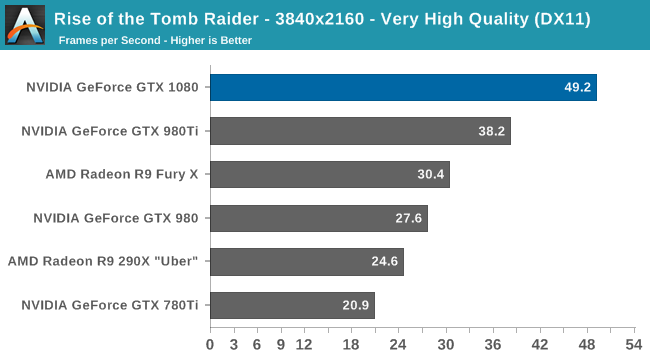

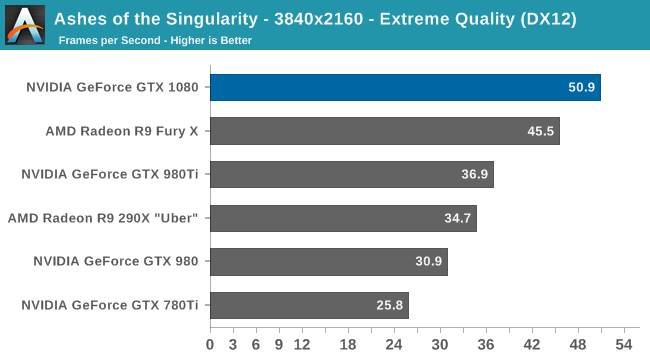

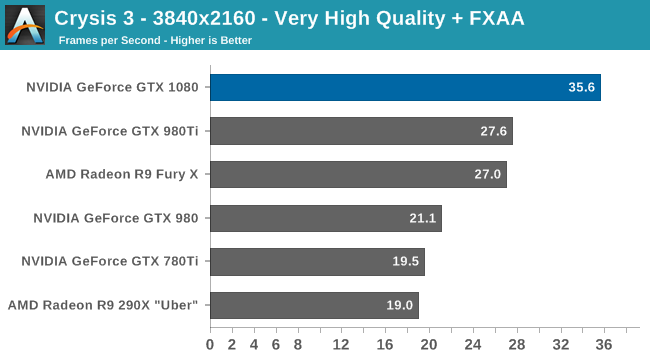
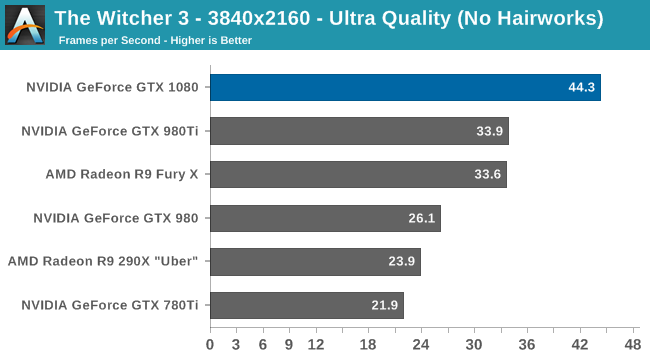
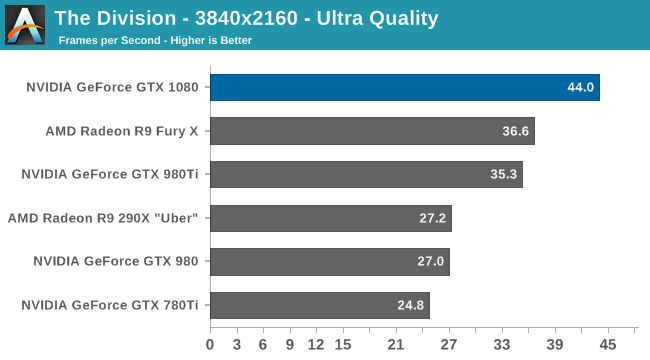
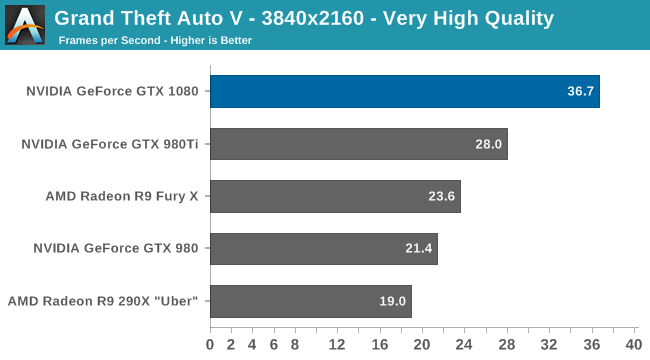
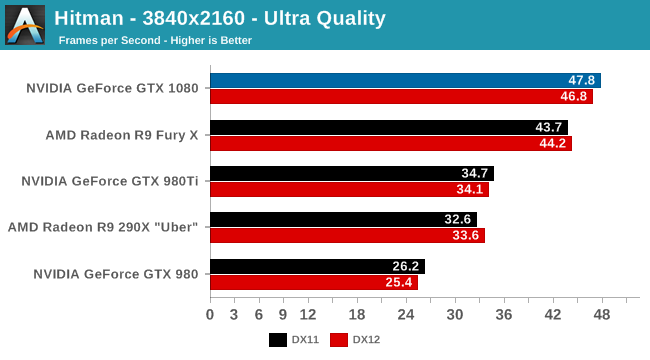
As the first high-end card of this generation to launch, NVIDIA gets to set the pace for the market. At the risk of being redundant the GTX 1080 is now the fastest single-GPU card on the market, and even at 4K it wins at every single gaming benchmark, typically by a good margin. In practice we’re looking at a 31% performance lead over GTX 980 Ti – the card the GTX 1080 essentially replaces – with a similar 32% lead over AMD’s Radeon R9 Fury X. Meanwhile against the slightly older GTX 980, that gap is 70%.
On a generational basis this ends up being very close to the 74% jump in 4K performance going from the GTX 680 to GTX 980. And although the pricing comparison is not especially flattering for NVIDIA here, it should be evident that NVIDIA isn’t just looking to sell GTX 1080 as an upgrade for high-end Kepler cards, but as an upgrade for GTX 980 as well, just 20 months after it launched.
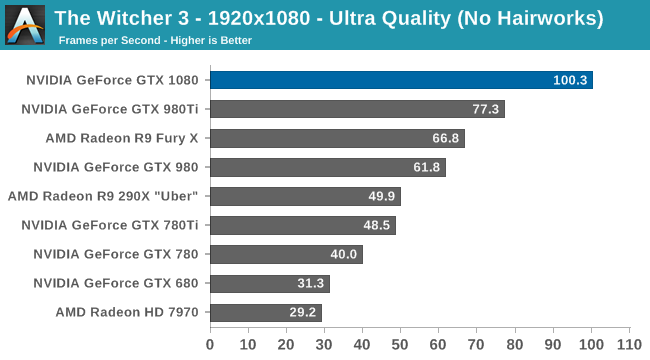
I also wanted to quickly throw in a 1080p chart, both for the interest of comparing the GTX 1080 to the first-generation 28nm cards, and for gamers who are playing on high refresh rate 1080p monitors. Though this will of course vary from game to game, roughly speaking the GTX 1080 should be 3x faster than the GTX 680 or Radeon HD 7970. This is a good reminder of how architectural efficiency has played a greater role in past years, as this is a much larger gain than we saw jumping from 55nm to 40nm or 40nm to 28nm, both of which were much closer to the historical norm of 2x.

Meanwhile when it comes to power, temperature, and noise, NVIDIA continues to execute very well here. Power consumption under Crysis 3 is some 20W higher than GTX 980 or 52W lower than GTX 980 Ti, generally in line with NVIDIA’s own TDP ratings after accounting for the slightly higher CPU power consumption incurred by the card’s higher performance. The end result is that GTX 1080 is a bit more power hungry than GTX 980, but still in the sweet spot NVIDIA has carved out in the gaming market. Broadly speaking, this amounts to a 54% increase in energy efficiency in the case of Crysis 3.
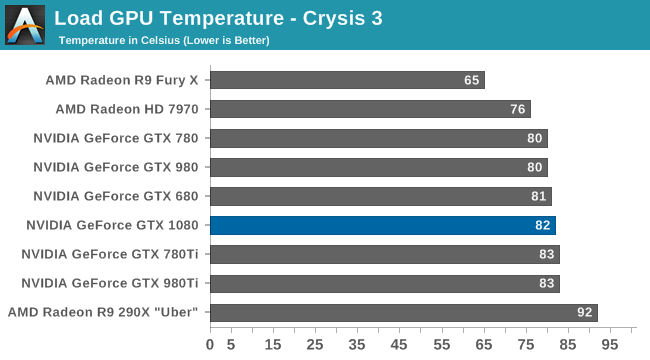
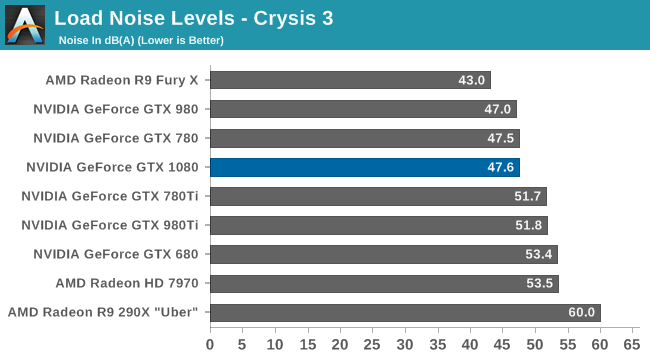
Otherwise from a design perspective the GTX 1080 Founders Edition carries on from NVIDIA’s high-end GTX 700/900 reference design, allowing NVIDIA to once again offer a superior blower-based solution. NVIDIA’s temperature management technology has not changed relative to Maxwell, so like their other cards, the GTX 1080 tops out in the low 80s for load temperature. More significantly, at 47.5 db(A) load noise, the card is on par with the GTX 780 and half a dB off of the GTX 980.
Ultimately NVIDIA has designed the GTX 1080 to be a drop-in replacement for the GTX 980, and this data confirms just that, indicating that GTX 1080’s much higher performance comes with only a slight increase in power consumption and no meaningful change in temperatures or acoustics.


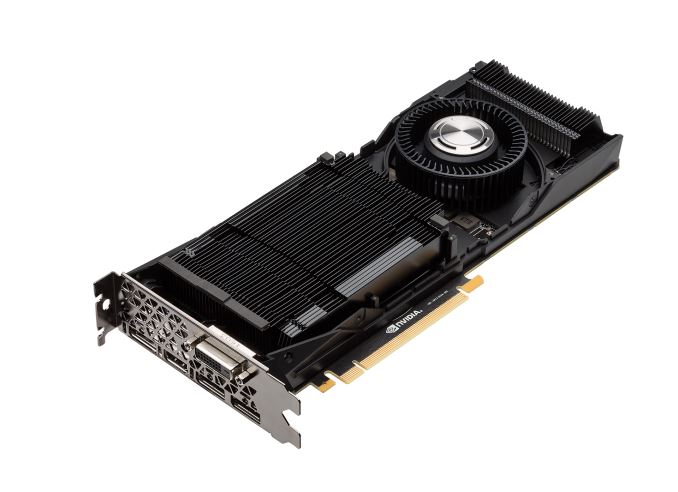








262 Comments
View All Comments
Yojimbo - Tuesday, May 17, 2016 - link
Well the vanilla 1080 will be $50 more than the vanilla 980 so that should be taken into account.BurntMyBacon - Tuesday, May 17, 2016 - link
@zoxo: "Don't forget that you should compare the GP104 chip to the GM104, so vanilla 980, as the 1080 Ti will come down the line"Architecturally, yes. That is the comparison to make. However, from a consumer standpoint, the 1080 is positioned as the new halo product and it comes in closer to the price of the older halo product (980Ti). Thus, until such a time as a new halo product (1080Ti? / Titan?) emerges, it will be compared to the 980Ti. Don't forget, the 980 was compared with the 780Ti and there was a significant time gap before the 980Ti hit the scene. I doubt a 1080Ti will be short in coming.
Commodus - Tuesday, May 17, 2016 - link
Better to be honest and post a preview than rush out a half-hearted review.3ogdy - Tuesday, May 17, 2016 - link
Hello Disappoint! How are you today?WinterCharm - Tuesday, May 17, 2016 - link
You must not be very familiar with Anandtech. Their full review takes time, but it will melt your face with how thorough it is.damianrobertjones - Tuesday, May 17, 2016 - link
Not disappointed?tipoo - Tuesday, May 17, 2016 - link
After being on 28nm since 2011, PC hardware is finally starting to get interesting again. Pascal, Polaris, Zen, exciting times.JimmiG - Tuesday, May 17, 2016 - link
"After being on 28nm since 2011, PC hardware is finally starting to get interesting again. Pascal, Polaris, Zen, exciting times. "Couldn't agree more. Even though this card makes my 970 look pathetic, it also makes me very happy to see these performance gains in an age where it looked like the entire PC market had stagnated.
If you ignore the price premium, this kind of leap over the 980 (which is the card that the GTX 1080 technically replaces), reminds of previous grand GPU launches like the Radeon 9700, GeForce 4, GeForce 8800 etc.
tipoo - Tuesday, May 17, 2016 - link
Even the 380 dollar 1070 should be a decent leap following this, as it still has Titan X beating performance. I hope both camps drive forward the 200 dollar price point performance.medi03 - Tuesday, May 17, 2016 - link
789€ for 1080 in Germany (announced Founders Edition price was 699$)Founders Edition 1070 was supposed to be 449$. So, I guess, 480-520€ (1 Euro is more than 1$, but somehow that's the pricing we get... =/)